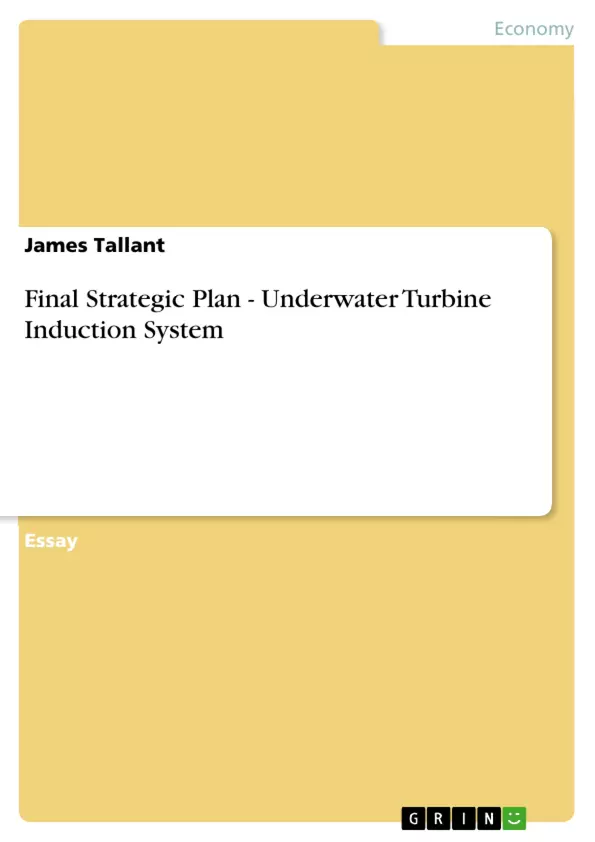Final Strategic Plan: Underwater Turbine Induction System
Many organizations have a plan or a piece of a plan. But only a few organizations have a thoroughly developed strategic plan. Strategic planning is a process that has a beginning and no ending. Beginning with the formation of a mission and core values statement, the process continues with the development of a vision statement, long-term objectives, SWOTT analysis, strategies, and short-term objectives.
Several behavioral effects of strategic management improve the organizations welfare such as strategy formulation that assist the organization’s ability to prevent problems, group-based strategic decisions draw the best alternative choices, the involvement of employees in strategy formulation improves the productivity-reward relationship, which heightens their motivation. In addition, the reduction of breaks and double work in activities among individuals and groups results from strategy formulation which clarifies differences in roles and assists in reduced resistance to change. Pearce and Robinson (2004) comment “A strategy reflects a company’s awareness of how, when, and where it should compete; against whom it should compete; and for what purpose it should compete” (p. 4, para. 4).
Importance of Strategic Planning and Management in the Business Environment
The business I want to start is a green eco-friendly organization that designs and builds water turbine induction systems for power creation and water desalination for the United States coastal regions. However, starting a business is a challenge. Without proper procedures and guidelines, a new business owner cannot identify and maintain a game plan to success. Creating a rough outline or game plan by the issuing of a mission statement is part of the strategic management process. To coincide with a mission statement, a vision statement describes what the organization wants to become. This paper offers ideas on how important these factors are as well as the four concepts of business: planning, leading, controlling, and organization are to the creating and implementation of a strategic business plan.
Inhaltsverzeichnis (Table of Contents)
- Importance of Strategic Planning and Management in the Business Environment
- Define Strategic Management and Planning
- Importance of a Strategic Plan to the Success of this Business
- Four Functions of Management
Zielsetzung und Themenschwerpunkte (Objectives and Key Themes)
This paper analyzes the importance of strategic planning and management in a business environment. It aims to illustrate how a strategic plan can be created and implemented to achieve a company's objectives. The paper uses the example of a green eco-friendly organization that designs and builds water turbine induction systems for power creation and water desalination. Key themes and main ideas explored in this document include:- The importance of a comprehensive strategic plan for business success
- The process of developing a strategic plan, including mission and vision statements
- The role of strategic management in achieving sustainable competitive advantage
- The four functions of management (planning, leading, controlling, and organizing) as they relate to strategic planning
- The significance of achieving short-term and long-term objectives through strategic management
Zusammenfassung der Kapitel (Chapter Summaries)
Importance of Strategic Planning and Management in the Business Environment
This chapter emphasizes the importance of a well-developed strategic plan for any organization. It discusses the challenges of starting a new business and highlights the need for proper procedures and guidelines to ensure success. The chapter outlines the key components of strategic management, including mission and vision statements, and emphasizes their role in establishing a clear direction for the business.Define Strategic Management and Planning
This chapter defines strategic management as a process that involves formulating and implementing plans to achieve a company's objectives. It outlines the nine key tasks involved in strategic management, such as formulating the company's mission, conducting internal and external analyses, and developing long-term and short-term objectives.Importance of a Strategic Plan to the Success of this Business
This chapter focuses on the specific application of strategic planning to a green eco-friendly organization that develops and builds water turbine induction systems. It emphasizes how strategic planning can help the business achieve sustainable competitive advantage, manage design costs, ensure quality, and enhance flexibility and responsiveness.Four Functions of Management
This chapter explores the four key functions of management - planning, leading, controlling, and organizing - and their crucial role in the creation and implementation of a strategic plan. It highlights how these functions are interconnected and essential for ensuring that the plan encompasses all aspects of the organization's internal and external environment.Schlüsselwörter (Keywords)
This paper centers around the concept of strategic management and planning, emphasizing its crucial role in achieving business success. Key terms explored include mission statement, vision statement, strategic planning, strategic management, sustainable competitive advantage, four functions of management (planning, leading, controlling, and organizing), short-term objectives, and long-term objectives. The paper also examines the application of these concepts within the specific context of a green eco-friendly organization developing and selling water turbine induction systems.- Quote paper
- James Tallant (Author), 2009, Final Strategic Plan - Underwater Turbine Induction System, Munich, GRIN Verlag, https://www.grin.com/document/167354



